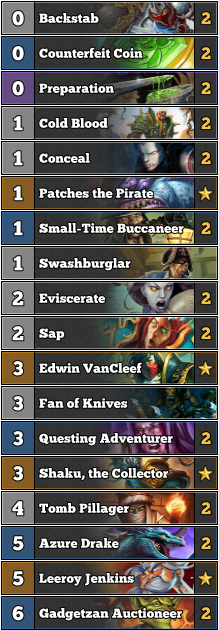|
Rogue. It’s kind of intimidating. Whenever you play against it on ladder, their cards just go WHOOSH and they always have some giant lethal threat… but when you play it, your cards just sit there in your hand and you fall behind on board right away. How is it always good on the other side of the table but so clunky to play with? Well, here’s the thing - Rogue is chronically misunderstood. The apparent game plan is very counterintuitive when one is behind the wheel and it often takes a big look at the overall game plan of the deck as well as some outside perspective to figure out how to win and how to not lose. In my case, the great @TheMVParker was gracious enough to provide me some coaching and it was truly eye opening. The below are my brief observations from playing Rogue exclusively this season. 1. You are an aggro deck. You are *not* midrange. You are *not* control. Your job is to present a steady stream of threats and force the opponent to run out of answers. Sometimes you will present unanswerable threats thanks to conceal - but while you will have high-damage burst turns, it’s a lot easier to just start carving chunks out of their life total on turn 1. (Thanks, small-time buc!) 2. You do not win the long game. You have no taunt. You have no heal. You have burst but limited removal. Sap (one of your best cards) is only good for buying tempo for a turn or two. Conceal preserves your damage for a turn or two. Furthermore, if you lay out your entire deck and your opponent lays out their entire deck and you each play one card at a time, almost every deck in the meta will beat you. The strength of your deck is combining your cards and resources in a way that allows you to cheat mana costs and create large, unanswerable tempo swings. This is true against aggressive decks as well. Shaman and pirate warrior have decks full of burn spells and independently powerful minions... and you have a bunch of coins and cold bloods. If you trade a lot and then expect to pull ahead in the late game, you will lose to 7/7s, jade golems, burn spells, or just piles of weapons. If you’re playing control, they will stabilize with life gain and defense. 3. The best defense is a good offense against the lower curve decks. You are incredibly unfavored against pirate warrior and not favored against aggro shaman either. So how do you win? Make a big dude before them! Avoid trading and push face damage! You will not keep pace with a deck that has a bunch of burn spells that kill your few minions and/or your face if you let them continue to draw cards - and the average power level in aggro shaman is way higher than yours. But if you are able to get an early big questing or E dwin and pressure the board, the game is very winnable. 4. Your resources are best spent to gain tempo and board presence in most matchups and you should win a lot of games empty handed. How valuable is 3 extra mana on turn 10? Both players have had 1+2+3+4+5+6+7+8+9+10 = 55 mana. Adding 3 gives you a 5.45% mana advantage. What about on turn 2? Both players have had 1+2 = 3 mana and you have spent 50% more mana in the early game. So what does this tell you about the value of prep? Furthermore, what does this tell you about the value of Edwin Van Cleef??? Very few decks in the game have the ability to both respond to threats and develop their own like rogue does. If you present a steady stream of threats, your opponents will generally be unable to both kill them and play their own. If they play their own, hit them in the face and either sap their minions, play more of your own threats, or conceal your guys - preferably all three. If they kill your guys, keep playing more and your gadget should be lucrative. 5. Sometimes they have it when you go for it… but you should go for it anyway. Renolock plays 1 card to kill a big questing or van cleef before turn 6 - blastcrystal potion. Sometimes they have it. The question you have to ask is - how do I win if I don’t go for it? Am I going to beat Renolock’s long game? You probably aren’t, and that means it’s probably right to go for it. The same might be true in the priest or warrior matchups. Sometimes it’s right to cold blood the patches early on to trade with a doomsayer and then hit face if they don’t kill it. The worst resources in your deck are the ones you never get to play, and you cannot account for every answer. Sometimes they have it and you lose. 6. Each situation is a little bit different - and you need to think before you play about how you’re going to win. Rogue is complicated. You can win with concealed questings. You can win with an early small time buc into tomb pillagers. You can win with a crazy gadget turn into leeroy combo. You can win by running out questing on 3 if you don’t think they can deal with it. There are many possibilities best learned through experience but also there are non-intuitive lines of play that deserve stopping and thinking for a second before making your move. 7. Learning your matchups is vital for getting better with the deck. Most of this is understanding your opponent’s removal options -- against some decks, they simply can’t kill a big questing or edwin early outside of 1 or 2 cards; e.g. renolock only has blastcrystal and siphon soul, druid only has 1 mulch. This is just one small example of matchup nuances to learn -- and your mulligan will frequently decide whether or not you win or lose. Here’s the list I’d recommend: Mulligans are still tricky for me, but here’s what I’ve been doing so far that generally works:
Always keep 100% of the time: Small time buc, Edwin, 1 Prep Keep against aggressive decks (including the mirror) or on the coin: Backstab, Swashburglar Keep if you have a hand that can play multiple spells for 0-1 mana: Questing (I like to keep Questing against aggressive strategies if I know it’s not just going to be a 3 mana 2/2) Keep against anything except aggro shaman and pirate warrior: Shaku, Tomb Pillager Keep against slower value decks (reno mage, jade druid, etc): Azure Drake With luck, these guidelines will help you win some games - now is a great time to learn miracle rogue before they nerf small-time! Feel free to leave questions, comments, and feedback below. Thanks for reading!
0 Comments
Leave a Reply. |
AuthorThe THL blog is curated and edited by THL's Content Managers. All THL members are welcomed and encouraged to pitch ideas for articles they would like to see on the site. If you have an idea, please reach out to LotusKnight on Discord or via the THL Help email address: [email protected] Archives
December 2023
Categories
All
|
This website is not affiliated with Blizzard Entertainment.
Icons made by Freepik & Smashicons from www.flaticon.com is licensed by CC 3.0 BY
Icons made by Freepik & Smashicons from www.flaticon.com is licensed by CC 3.0 BY


 RSS Feed
RSS Feed